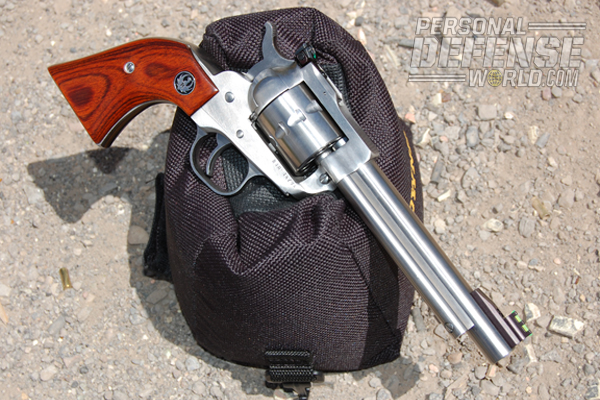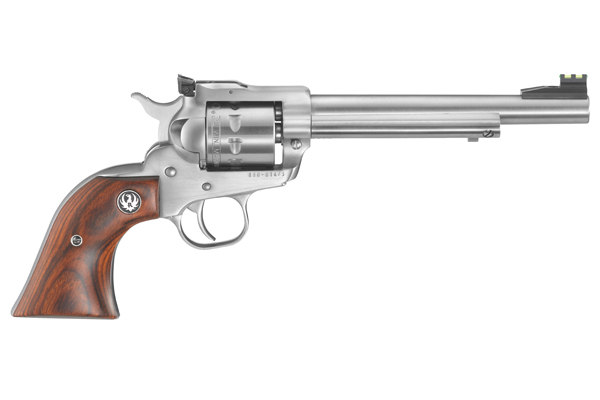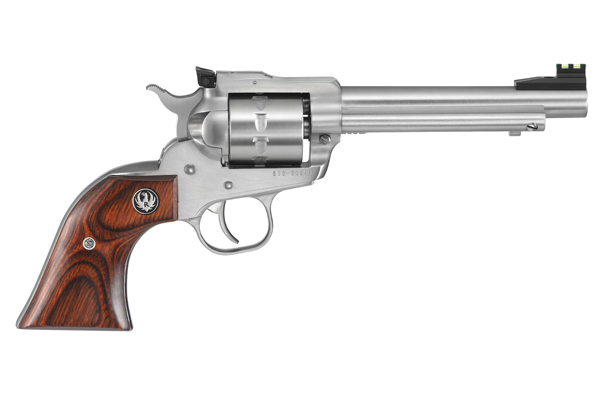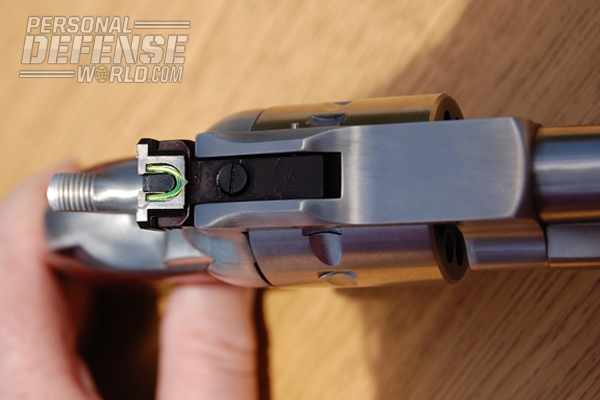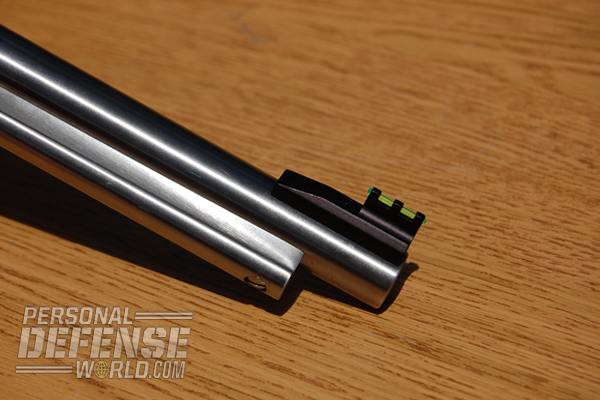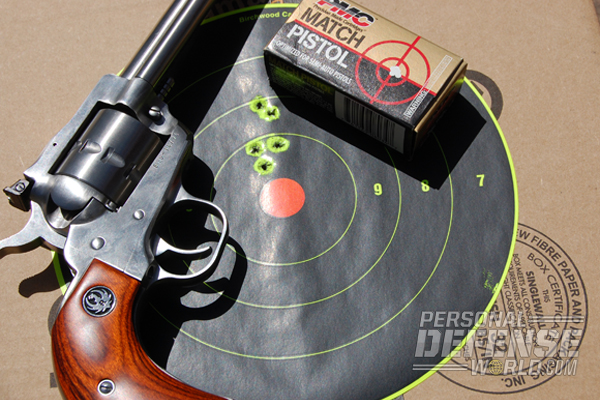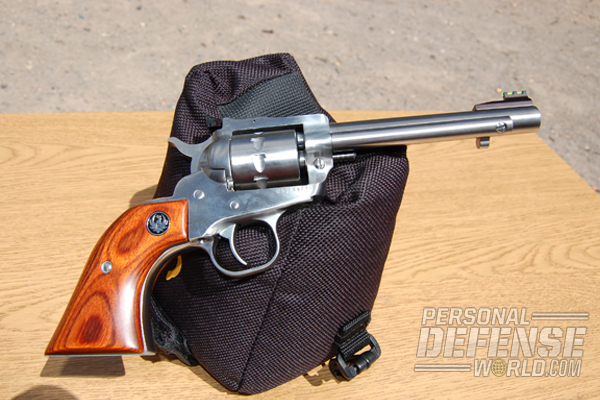In 1949, Sturm, Ruger & Co. began business by introducing its Standard Model .22 autopistol. The iconic handgun was an immediate success, launching the company that soon became one of America’s premier gunmakers. Shooters flocked to buy one these guns, which vaguely resembled the German Luger. It was the company’s first product and it sold like crazy. I’ve owned several, including a highly customized Mark I that is among my most prized possessions.
Four years later, Ruger announced a .22 revolver called the Single-Six. The high-quality, American-made, single-action (SA) sixgun quickly racked up impressive sales as it created new interest in the “thumbuster” sixguns of earlier times. In 1973, Ruger added a transfer bar mechanism that made the gun much safer to carry with all six chambers loaded and the hammer down on a loaded chamber. Prior to this innovation, it was wise to load only five chambers of SA revolvers. The transfer bar safety allowed sixguns to be fully loaded without endangering the user.
Single-Six variations included a model with .22 LR and .22 HMR interchangeable chambers. Simply switching cylinders allowed the revolver to digest either kind of ammunition. Other chamberings included a .32 H&R Mag centerfire that accounted for several desert-dwelling jackrabbits before I finished my testing and returned the gun to Ruger. I still wish I’d bought that gun. Sadly, this model has long since been discontinued.
Advertisement — Continue Reading Below

The latest versions of Ruger’s sixgun aren’t actually sixguns. Introduced in 2012, the new Ruger Single-Ten chambers 10 rounds of .22 LR ammunition. The even newer Single-Nine holds nine .22 WMR cartridges. While those larger capacities allow you to fire more shots before reloading, speed isn’t the issue here. It takes longer to eject empties and reload each cylinder.
When test samples arrived from Ruger, I admired them briefly and then took them to my shooting range for a trial run. While the Single-Ten functioned beautifully, the Single-Nine .22 WMR was dead out of the chute. The cylinder was tightly locked up, and my best efforts couldn’t free it. No matter what I tried, the gun remained stubbornly nonfunctional.
In a lifetime of testing and writing about firearms, I’ve encountered dozens that were shabbily made or performed poorly. This was the very first time a Ruger had let me down. I returned the gun to the factory, and it was quickly replaced by a Single-Nine that worked. Considering the large number of Ruger guns that have functioned flawlessly for me in the past, I’m viewing this as a statistical anomaly. My faith in Ruger firearms remains undiminished.
Advertisement — Continue Reading Below
Gun Details

Visually, the Single-Nine and Single-Ten revolvers are all but identical. At the moment, the Single-Nine is offered with a 6.5-inch barrel, while the Single-Ten’s barrel is an inch shorter. The .22 WMR weighs in at 39 ounces, while the .22 LR version weighs an ounce less. I expect other barrel lengths to appear soon.
Both guns wear flawless satin stainless steel finishes and fluteless cylinders. A legend identifying the cartridge is engraved around the rear of the .22 WMR cylinder. The Single-Ten’s .22 LR cylinder lacks this adornment.
Advertisement — Continue Reading Below
Ruger’s New Model transfer bar safeties are standard. The smooth, laminated Hardwood Gunfighter grips—less bulky than Ruger’s usual SA grips—are very attractive and feel great in the hand. These two revolvers have excellent balance and natural “pointability,” long a hallmark of classic SA six-guns.

Each gun wears click-adjustable Williams fiber-optic sights that display a pair of glowing green dots at the rear, which bracket the front sight’s larger single dot. These sights are easy to pick up under almost any lighting conditions. They’re among the best factory iron sights I’ve seen on any handgun.
Cylinder-to-frame fit is tick-tight on either revolver. Tolerances are very close. When rotating the cylinders to eject empties, each chamber lines up exactly with the ejector rod with an audible click. This facilitates fast, fumble-free loading or unloading. Unlike most cowboy-styled SA revolvers, it’s not necessary to place the hammer at “half cock” before the cylinder can be rotated. The cylinder can be turned only when the hammer is positioned forward and the loading gate is opened. Actually, neither gun can be set in the half-cock position. The hammer must be fully forward, or locked to the rear and ready to fire. Once the hammer is cocked in the “fire” position, the trigger must be consciously pulled before the transfer bar rises to form a bridge between hammer and firing pin. Only then can the floating firing pin drive forward and impact the rimfire primer.
Advertisement — Continue Reading Below
Trigger action is crisp and positive. The Single-Nine’s trigger breaks at an even 4 pounds with no discernable creep or overtravel. The Single-Ten requires 5 pounds of trigger pressure to drop the hammer. Again, no creep or overtravel was present.
Shooting Impressions

Regardless what kind of gun I’m shooting, I want to hit what I’m aiming at. Accuracy is relative—you can’t expect the kind of precision you get with a finely tuned .22 target gun when you switch to a harder-kicking .44 Mag or something producing a .500 S&W punch.
Advertisement — Continue Reading Below
“I attribute this kind of accuracy to the steadying heft these guns provide, along with tight tolerances, excellent sights and crisp, controllable triggers.”
Rimfires are another story. They produce minimal recoil and are designed for hunting small game, plinking and target shooting. Both of Ruger’s new SA rimfires delivered commendable accuracy. I fired both guns from a sandbagged rest (only the butt was steadied by sandbags) using a variety of .22 WMR and .22 LR loads. The range was 25 yards.
All of the .22 LR loads I tried delivered more than acceptable accuracy. The best Single-Ten performance came with PMC Match Pistol ammunition (which the carton said was “optimized for semi-auto pistols.”) Five-shot groups averaged 1.65 inches between centers. Winchester’s 40-grain Super-X load regularly punched 2.20-inch groups.
The .22 WMR Single-Nine revolver seemed to prefer Winchester’s 28-grain jacketed hollow-points, averaging 1.72-inch five-shot spreads. Other .22 WMR ammunition I tried yielded groups hovering around the 2.25-inch mark.
Advertisement — Continue Reading Below
I attribute this kind of accuracy to the steadying heft these guns provide, along with tight tolerances, excellent sights and crisp, controllable triggers. Ergonomic grips were also a big help.
Final Notes

Advertisement — Continue Reading Below
Ruger’s new high-capacity single-action rimfires look like real winners to me. Once the balky gun had been quickly replaced, the Single-Nine and Single-Ten revolvers did themselves proud. These are some of the best-looking, easiest-handling new guns I’ve recently had the chance to use. In addition to surprising accuracy, these Western-styled revolvers offer real pride of ownership and should last a couple of lifetimes.
How well do I like Ruger’s new high-capacity SA revolvers? Right now, I own many more firearms than anyone really needs. I’m also notoriously tight-fisted. The fact that I’m seriously considering buying one of these guns (haven’t decided which one yet) when the manufacturer wants them returned at the end of the consignment period tells you a lot about that.
For more information, visit http://www.ruger.com.
Advertisement — Continue Reading Below
